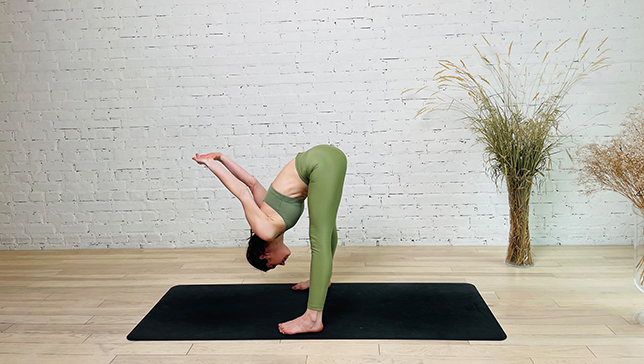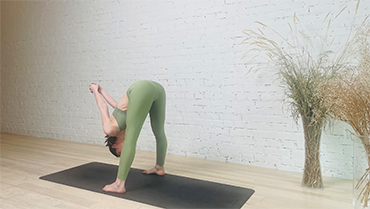Standing Yoga Seal - Dandayamana Mudrasana

Contents
Standing Yoga Seal or Dandayamana Mudrasana (DAHN-DAY-YAHM-NAH-MOO-DRAHS-ANNA) – also known as Standing Yoga Mudra Pose – offers a great stretch for the arms, shoulders, chest, legs, and upper back, and is a good pose for those who spend a lot of time sitting at a computer. It helps loosen up tight muscles in the upper back and neck, and is also believed to improve mental functions and harmonize the heart and mind.
This beginner-level pose is thought to help open the Heart chakra, and is a good one to include in any heart-chakra-focused sequences.
Standing Yoga Seal is often practiced at the halfway point of a yoga class, once the muscles of the body are warm and able to release into the stretch.
The hands begin together behind the back and then are lifted as the body moves forward, providing a strong stretch for the front of the chest and helping to open the shoulders. The forward fold stretches the hamstrings and the muscles of the back of the body, helping to release tension. This posture is an inversion, as the head is lowered to a level below the heart.
Pose Detail
- Difficulty: Beginners
- By Type: Flexibility Yoga Poses, Strengthening Yoga Poses
- Body Position: Forward Bend Yoga Poses, Inversion Yoga Poses, Standing Yoga Poses
- By Benefit: Yoga Poses For Digestion, Yoga Poses For Stress Relief
Step-by-Step Instructions
Benefits and Contraindications
Increases blood circulation in the upper body, and strengthens the muscles of the pelvis, lower back, hips and abdomen.
Increases shoulder mobility, stretches the torso, and engages the shoulder muscles, helping it to become stronger
Stretches and massages your spine
Strengthening your shoulders and neck
Helps in reducing stress and anxiety
High blood pressure
Chronic head, neck, shoulder, back, arms injuries
Photo poses in different angles

Modifications and Props for Beginners
- You can practice the pose with your back against a wall for added stability.
- If you have tight hamstrings, you can bend your knees slightly to make the pose more accessible.
- If you have low back pain, you can perform the pose with your hands on your hips instead of clasping them behind your back.
- A yoga strap can be helpful if you have limited flexibility in your shoulders or cannot comfortably clasp your hands behind your back. Simply hold onto the strap with both hands, and use it to create a comfortable distance between your hands.
Useful Tips
- Those starting with the standing yoga seal pose should bear in mind that a tight chest and hamstrings tend to restrict movement and hence you should do some amount of light stretching or warm-ups before getting into this pose.
Frequently Asked Questions
Common mistakes include collapsing into the standing hip, rounding the shoulders, and lifting the chin. It is important to keep the standing leg strong and engaged, shoulders relaxed and down, and gaze forward to maintain proper alignment.
While this pose is accessible to many people, it may be challenging for those with certain injuries or conditions, such as ankle or knee pain, low back pain, or high blood pressure. It is important to listen to your body and consult with a qualified yoga teacher or healthcare provider if you have any concerns.
If you cannot comfortably clasp your hands behind your back, you can use a strap to create a comfortable distance between your hands, or simply rest your hands on your hips.
If you have low back pain, it’s important to modify the pose by keeping your hands on your hips or avoiding the pose altogether. Consult with a healthcare professional or a yoga teacher for guidance.
You can hold the pose for 30 seconds to 1 minute on each side. Gradually increase the duration as you become more comfortable and confident in the pose.
Variations
- Camel Pose
- Half Camel Pose
- Half Standing Yoga Seal
- One-legged Standing Yoga Seal
- Standing Yoga Seal with Forward Fold